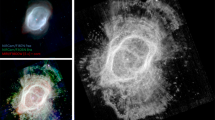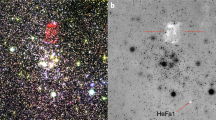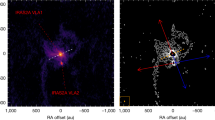Abstract
The final expulsion of gas by a star as it forms a planetary nebula — the ionized shell of gas often observed surrounding a young white dwarf — is one of the most poorly understood stages of stellar evolution1,2. Such nebulae form extremely rapidly (about 100 years for the ionization) and so the formation process is inherently difficult to observe. Particularly puzzling is how a spherical star can produce a highly asymmetric nebula with collimated outflows. Here we report optical observations of the Stingray nebula3,4, which has become an ionized planetary nebula within the past few decades5. We find that the collimated outflows are already evident, and we have identified the nebular structure that focuses the outflows. We have also found a companion star, reinforcing previous suspicions that binary companions play an important role in shaping planetary nebulae and changing the direction of successive outflows6.
This is a preview of subscription content, access via your institution
Access options
Subscribe to this journal
Receive 51 print issues and online access
$199.00 per year
only $3.90 per issue
Buy this article
- Purchase on Springer Link
- Instant access to full article PDF
Prices may be subject to local taxes which are calculated during checkout


Similar content being viewed by others
References
Kwok, S. in Late Stages of Stellar Evolution (eds Kwok, S. & Pottasch, S. R.) 321–335 (Kluwer Academic, Dordrecht, (1987)).
Maddox, J. Making sense of dwarf-star evolution. Nature 376, 15 (1995).
Henize, K. G. Observations of southern planetary nebulae. Astrophys. J. Suppl. Ser. 14, 125–153 (1967).
Henize, K. G. Observations of southern emission-line stars. Astrophys. J. Suppl. Ser. 30, 391–550 (1976).
Parthasarathy, M. et al. SAO 244567: a post-AGB star which has turned into a planetary nebula within the last 40 years. Astron. Astrophys. 267, L19–L22 (1993).
Youngelson, L. R., Tutukov, A. V. & Livio, M. The formation of binary and single nuclei of planetary nebulae. Astrophys. J. 418, 794–803 (1993).
Bobrowsky, M. Narrowband HST imagery of the young planetary nebula Henize 1357. Astrophys. J. 426, L47–L50 (1994).
Borkowski, K. J. et al. Collimation of astrophysical jets: the proto-planetary nebula He3-1475. Astrophys. J. 482, L97–L100 (1997).
Cantó, J. Astellar wind model for Herbig-Haro objects. Astron. Astrophys. 86, 327–338 (1980).
Morris, M. in From Miras to Planetary Nebulae (eds Mennessier, M. O. & Omont, A.) 520–535 (Frontières, Gif-sur-Yvette, (1990)).
Soker, N. & Livio, M. Disks and jets in planetary nebulae. Astrophys. J. 421, 219–224 (1994).
Mellema, G. Astrophys. Space Sci. 245, 239–253 (1996).
Frank, A. et al. Amechanism for the production of jets and ansae in planetary nebulae. Astrophys. J. 471, L53–L56 (1996).
Frank, A. & Mellema, G. in Herbig-Haro Flows and the Birth of Low Mass Stars (eds Reipurth, B. & Bertout, C.) 291–302 (Kluwer Academic, Dordrecht, (1997)).
Kozok, J. R. Photometric observations of emission B-stars in the southern Milky Way. Astron. Astrophys. Suppl. Ser. 61, 387–405 (1985).
Kozok, J. R. Distances, reddening, and distribution of emission B-stars in the galactic centre region |l| ≤ 45 deg. Astron. Astrophys. Suppl. Ser. 62, 7–16 (1985).
Bobrowsky, M. et al. He3-1475 and its jets. Astrophys. J. 446, L89–L92 (1995).
Riera, A. et al. IRAS 17423-1755 [He3-1475]: a massive post-AGB star evolving into the planetary nebula stage? Astron. Astrophys. 302, 137–153 (1995).
Livio, M. & Pringle, J. E. The formation of point-symmetric nebulae. Astrophys. J. 465, L55–L56 (1996).
Livio, M. & Pringle, J. E. Wobbling accretion disks, jets, and point-symmetric nebulae. Astrophys. J. 486, 835–839 (1997).
Ratnatunga, K. U., Bahcall, J. N. & Casertano, S. Kinematic modeling of the galaxy I. The Yale bright star catalog. Astrophys. J. 339, 106–125 (1989).
Casertano, S., Ratnatunga, K. U. & Bahcall, J. N. Kinematic modeling of the galaxy. II. Two samples of high proper motion stars. Astrophys. J. 357, 435–452 (1990).
Icke, V., Balick, B. & Frank, A. The hydrodynamics of aspherical planetary nebulae II. Numerical modelling of the early evolution. Astron. Astrophys. 253, 224–243 (1992).
Livio, M. HST observations of nebular morphologies and their implications. Space Sci. Rev. (in the press).
Kolesnik, I. G. & Pilyugin, L. S. The influence of a binary nucleus on the structure of planetary nebulae. Sov. Astron. 30, 169–173 (1986).
Sahu, K. C. & Desai, J. N. Kinematic structure of NGC 3132: the planetary nebula with a binary nucleus. Astron. Astrophys. 161, 357–362 (1986).
Pottasch, S. R. Planetary Nebulae 51–70 (Reidel, Dordrecht, (1983)).
Parthasarathy, M. et al. Fading and variations in the spectrum of the central star of the very young planetary nebula SAO 244567 (Hen 1357). Astron. Astrophys. 300, L25–L28 (1995).
Feibelman, W. A. Recent changes in the IUE spectrum of the very young planetary nebula He3-1357 ( = SAO 244567). Astrophys. J. 443, 245–248 (1995).
Blöcker, T. & Schönberner, D. Stellar evolution of low and intermediate-mass stars. III. An application of evolutionary post-AGB models: the variable central star FG Sagittae. Astron. Astrophys. 324, 991–997 (1997).
Blöcker, T. & Schönberner, D. On the fading of massive AGB remnants. Astron. Astrophys. 240, L11–L14 (1990).
Acknowledgements
We thank T. Heckman for suggestions, M. Livio for discussions, and A. Frank for comments. This work is based on observations with the NASA/ESA Hubble Space Telescope, obtained at the Space Telescope Science Institute, which is operated by the Association of Universities for Research in Astronomy, Inc., under NASA contract.
Author information
Authors and Affiliations
Corresponding author
Rights and permissions
About this article
Cite this article
Bobrowsky, M., Sahu, K., Parthasarathy, M. et al. Birth and early evolution of a planetary nebula. Nature 392, 469–471 (1998). https://doi.org/10.1038/33092
Received:
Accepted:
Issue Date:
DOI: https://doi.org/10.1038/33092
Comments
By submitting a comment you agree to abide by our Terms and Community Guidelines. If you find something abusive or that does not comply with our terms or guidelines please flag it as inappropriate.



